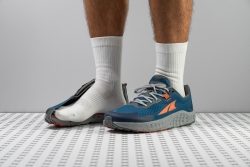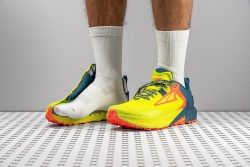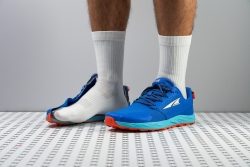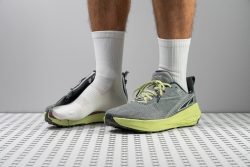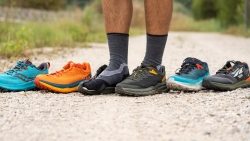7 Best Altra Trail Running Shoes in 2025
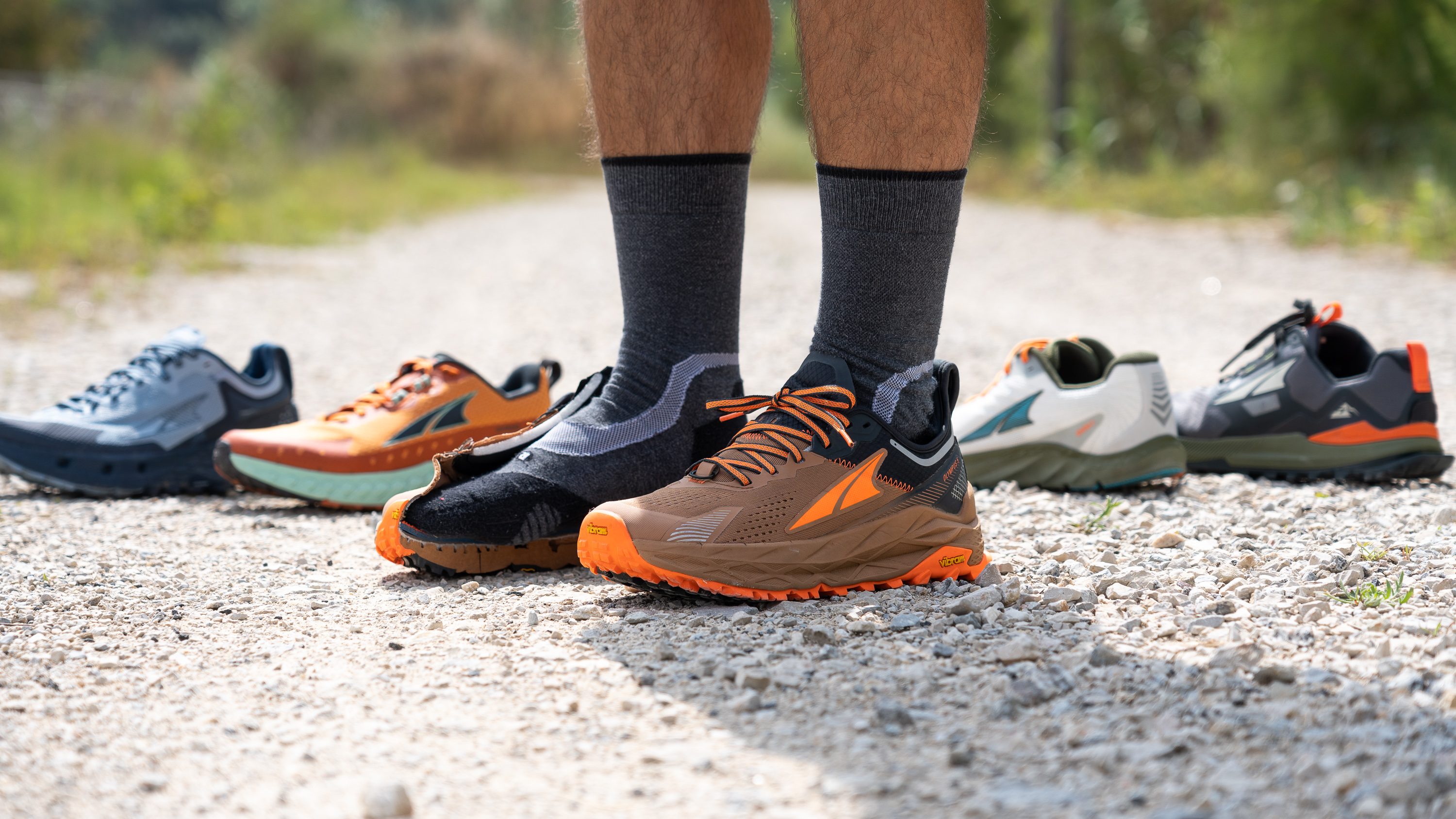
We buy shoes ourselves. We earn commissions when you buy through us, at no extra cost. Why trust us
From your local trails to rugged, technical terrains, if you need a truly reliable and comfortable trail partner, you can’t go wrong with Altra. That is, if you're ok with a zero drop, or at least a low drop, and a wide toebox.
Known by hardcore trail runners for their foot-shaped, zero-drop trail shoes like the Lone Peak and Altra Timp series, Altra trail running shoes are gaining more traction and popularity among regular off-road enthusiasts and long-distance trail runners.
To help you find the right model for your needs, we’ve handpicked, tested, and reviewed Altra trail running shoes. Here, we showcase our top picks.
We also encourage you to read our guide section because it covers everything about Altra's heel to toe drop, who it's good for and when zero drop is NOT actually zero drop, different shoe widths that Altra offers (backed by our lab data, of course), the durability of their shoes, and much much more!
How we test Altra trail running shoes
Working with our team of wear-testers and editors here at RunRepeat, we thoroughly tested and analyzed every model on this list. To give you an idea of how we make our final recommendations, here's our workflow:
- We buy all the Altra trail shoes using our own funds to ensure 100% bias-free reviews.
- We cut the shoes in half and test them in our lab, measuring 30+ parameters, from the outsole traction and durability to platform stiffness and breathability, among others.
- We do test runs in each pair. We make sure to cover everything, from loose, soft ground and muddy areas to rocky and very demanding terrain. We also take note of all the details, like velcro patches for gaiters, separate plates that can be inserted below the insole, etc.
- We publish all the details and lab data in our reviews. Lab data is presented in a way that allows you to compare any feature across different shoes, so if you prioritize lug depth, you can easily find Altra trail shoe with the deepest lugs!
Best Altra trail running shoes overall



















































What makes it the best?
The Lone Peak 9 seamlessly transitions between leisurely hikes and high-speed intervals in rugged terrain. Its grippy base and balanced, close-to-the-ground platform amplify our control, a vital aspect of trail running. It’s a no-brainer that the LP9 is our top pick from our lab-tested Altra trail roster.
Lone Peak 9 represents Altra’s zero-drop feature well with its 23.3/23.3 mm stack, a true flat incline compared to the 7.5 mm average. This gives us higher ground feedback for easier adaptation and a more balanced stance, especially with the firm 23.6 HA foam that won’t compress unevenly.
Analyzing the LP9+ version in the lab, we discovered it has the very grippy Vibram Megagrip rubber, which explains why it bit all types of surfaces we tested. Traction is further enhanced with its 3.8 mm lugs, which are shaped like arrows to improve control during ascents and descents.
However, we find its 10.9 oz (309g) too heavy for its size. Those expecting a lightweight running sensation should look elsewhere.
Pros
- True zero-drop geometry
- Extra-roomy, foot-shaped toebox
- Vibram option finally available
- Improved forefoot stability
- Flat-profile, natural ride
- Secure lacing system
- Still a low-stack shoe!
- Standard and wide versions
- Good durability
Cons
- Feels really heavy for its size
- Stiffer than previous versions
- Lacks airflow
- Having two outsole versions adds confusion
Altra trail running shoes with the best shock absorption
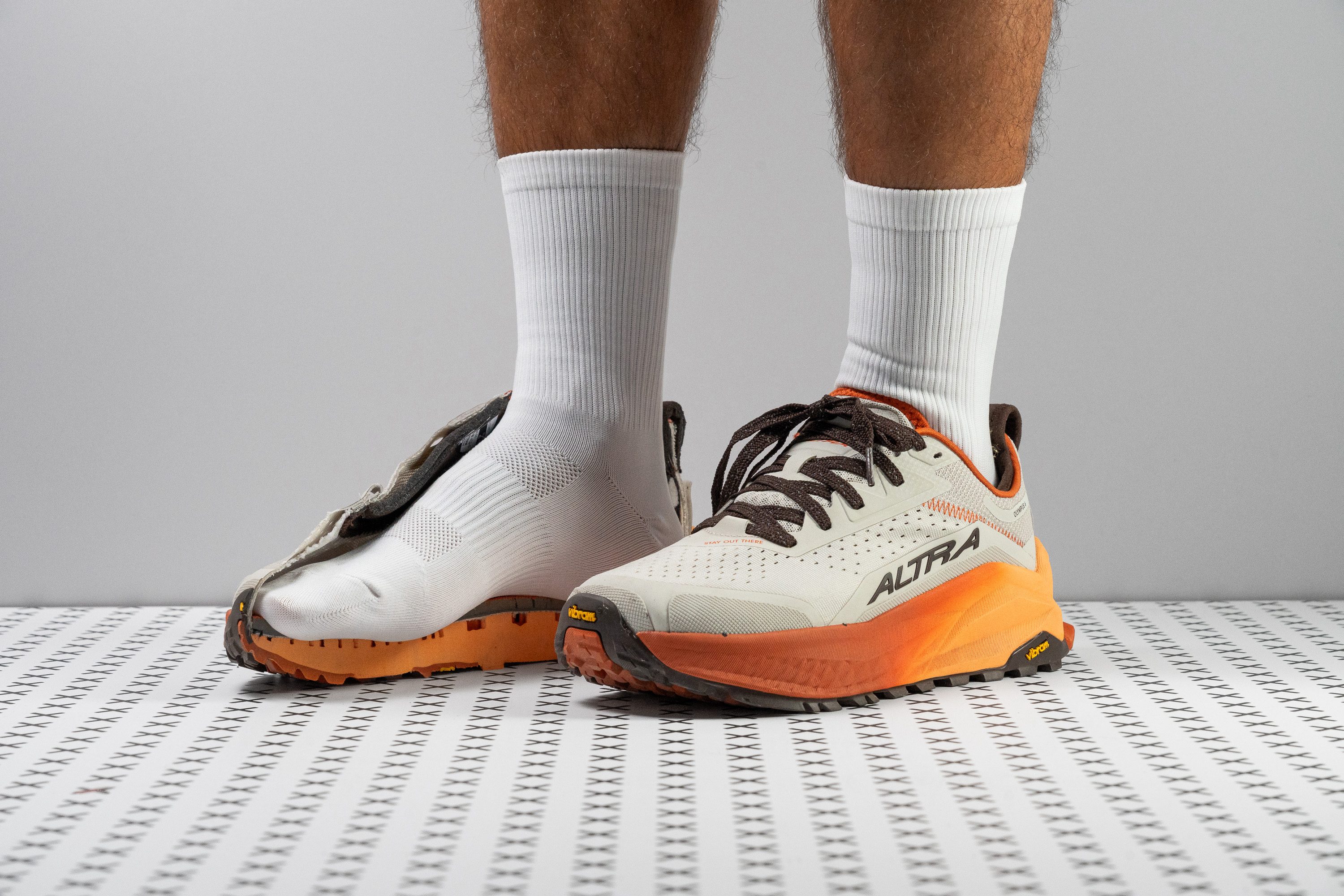

























































What makes it the best?
Armed with the grippy Vibram Megagrip outsole and protective midsole, we felt safe and comfortable during our terrain runs in the Olympus 6. It delivers a true zero-drop experience without sacrificing a pleasant ride, as it secures the top spot for shock absorption among Altra trail running shoes in the lab.
Our measurements reveal a heel drop of just 0.7 mm, creating a flat and stable ride. Despite the low drop, the ride feels exceptionally cushioned thanks to the impressive 31.5 mm forefoot stack, 6.9 mm above average. On top of this, it received a high 123 SA in our shock absorption test, confirming its ability to reduce stress on our legs.
The shoe’s low configuration and tall sidewalls contribute to a stable ride, and the renowned Vibram Megagrip outsole elevates traction further. With deep 3.5 mm lugs, we could easily navigate through loose ground or wet rocks. It also performed admirably in our Dremel test, showing only minor scuffs and proving its durability.
Unlike most trail shoes, Olympus 6 aced our breathability test with a 5/5 score. Our microscope shows the upper design features holes for ventilation and denser sections for support. In our abrasion test, Olympus 6 also earned a perfect score, a rare feat for highly breathable shoes.
However, while generous in cushioning, we find that the Olympus lacks energy rebound. Those who crave a responsive ride should check alternatives.
Pros
- Outstanding durability
- Superior build quality
- Grippy Vibram outsole
- Exceptionally comfortable
- Real 0-mm drop
- Ready for the toughest adventures
- Spacious, foot-shaped toebox
- Premium quality materials
Cons
- Extremely heavy
- Slight price increase
- Lacks energy return
Best road-to-trail Altra running shoes





















































What makes it the best?
Out of all the Altra trail running shoes we wore and lab-tested, Outroad 3 is the best hybrid shoe as it gives the most seamless road-to-trail transitions. It has a maneuverable midsole and a zero drop that keeps the feel natural. We find that it doesn’t sacrifice comfort for grip and stability on multiple terrains.
Outroad 3 boasts of a MaxTrac outsole lined with 1.5 mm lugs. We find this depth ideal for a hybrid shoe since it’s grippy enough for well-maintained paths and not too blocky on the streets. Plus, its weightlessness feels easy to maneuver. Our scales show it’s 10.6% lighter than the average trail shoe.
The zero drop is emphasized upon wearing the shoe and our caliper shows a minimal and forgivable 0.6 mm heel drop. This design promotes our natural strides, delivering a barefoot experience. Enhancing our comfort and agility is the unresisting midsole, which our bend test proves is 23.8% more flexible than average.
This Altra’s overall ride feels very stable and secure. The stack remains close to the ground at 23.8/23.2 mm. Together with the support of the midsole sidewalls, we remain steady by avoiding excessive foot motions.
Because of its low drop, heel strikers will feel challenged in this pair. We can only recommend this shoe to mid and forefoot strikers.
Pros
- Excellent for zero-drop fans
- Performs well on both road and trail
- Roomy, foot-shaped upper
- Can be used for hiking
- Perfect as a single-shoe travel option
- Reflective details
- Comfortable upper
- Lightweight
Cons
- Durability issues
- Not for heel strikers
- Limited breathability
Best Altra trail shoes for daily running
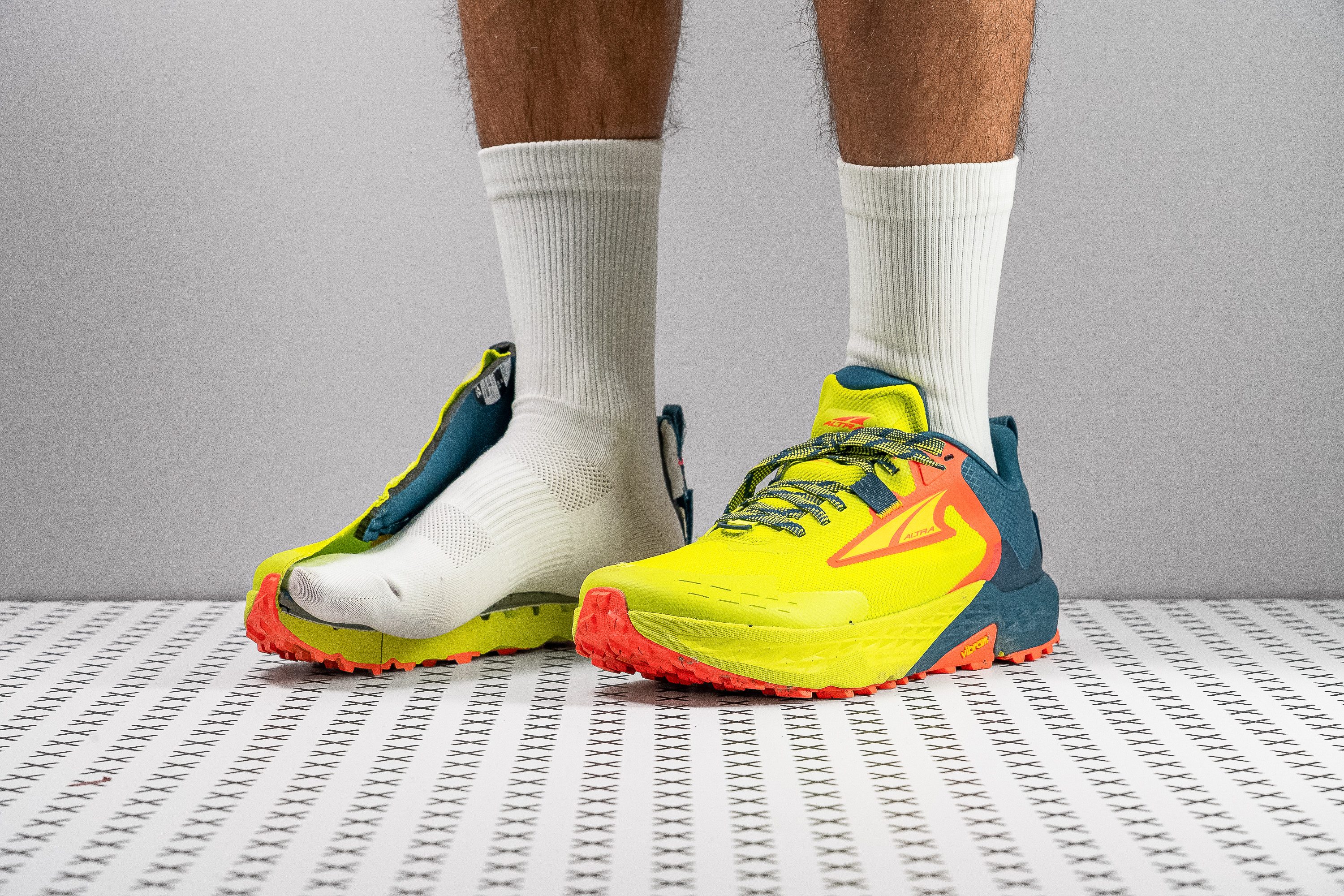


















































What makes it the best?
The Timp 5 boasts a high level of versatility, performing well both in the lab and on actual trail runs. With its light build, stable ride, and world-class Vibram Megagrip outsole, it is undoubtedly our top daily trainer among Altra trail running shoes.
Running in the Timp 5 feels like having the grip of trail shoes with the agility of road-running shoes. Weighing just 9.5 oz (269g) compared to the 10.4 oz (294g) average trail shoe, it's remarkably lightweight and adapts easily to split-second foot adjustments.
The midsole has ample cushioning for comfort and support. Our durometer shows a well-balanced 24.5 HA reading, enhancing stability together with the shoe’s zero drop. Our precise measurements reveal a negligible -0.1 mm drop, proving Timp 5 features Altra’s distinct trademark.
Underfoot is the standout Vibram Megagrip outsole, known for its exceptional traction, which we had the privilege of experiencing in our runs. It has 3.0 mm lugs that grip very well on mixed terrains, instilling confidence in our trail explorations. Its depth even allows for some occasional road running as well.
Unfortunately, the shoe feels quite rigid and stacked. Those who prefer a stronger ground connection should try other options.
Pros
- Vibram Megagrip outsole!
- Massive weight improvement
- Exceptionally stable
- True zero drop
- Ample cushioning
- Secure fit
- Wide, foot-shaped toebox
- Versatile
Cons
- Needs a better foam
- Not for heel strikers
Best Altra trail running shoes for racing
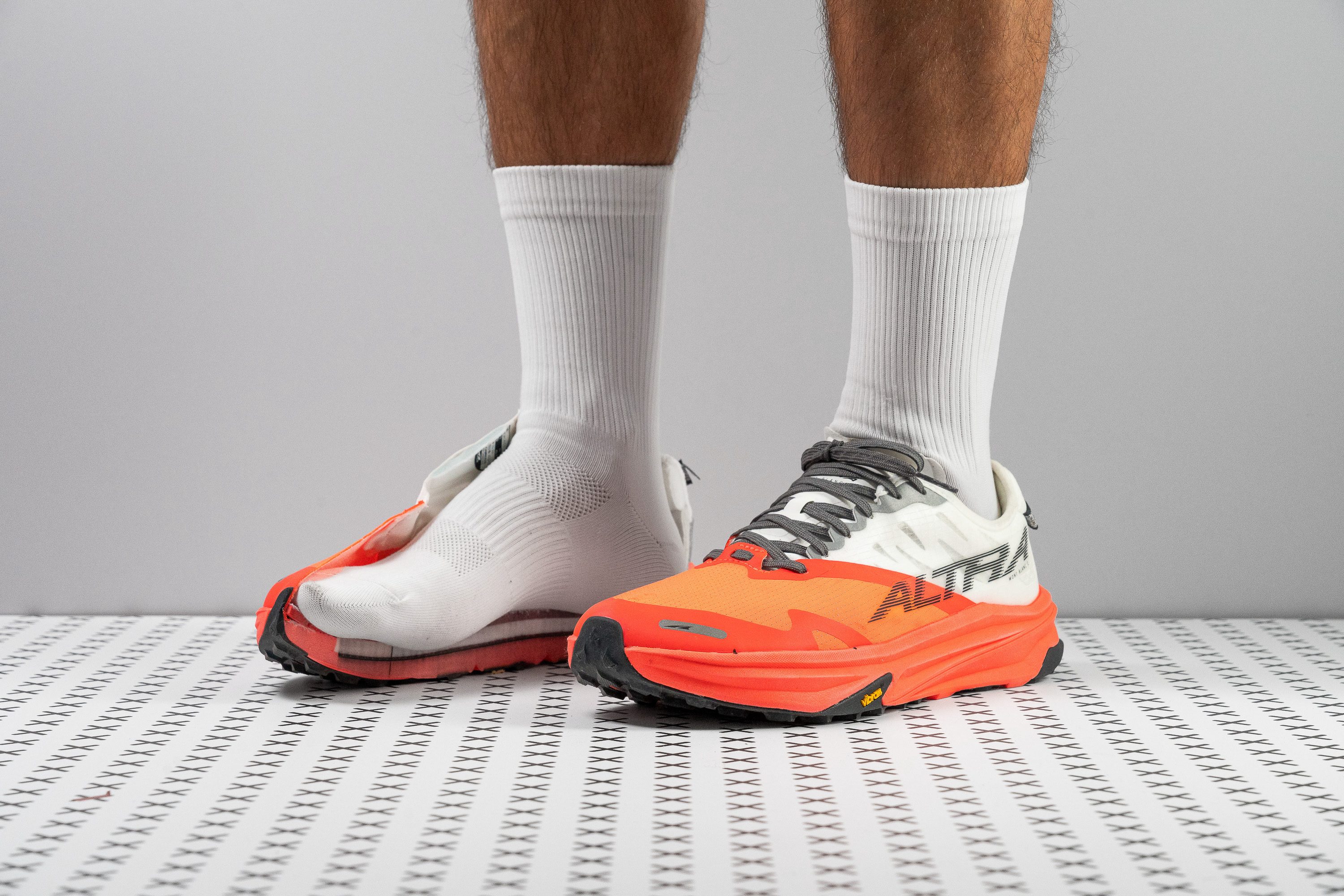



















































What makes it the best?
Backed by both real-world trials and lab assessments, the already speedy Mont Blanc now boasts an exciting enhancement: a revolutionary carbon plate that feels both fast and comfortable. This innovation propelled us to new heights, aided by its lightweight design and exceptional Vibram Megagrip outsole, undeniably making it our top Altra trail racer.
MBC feels exceptionally light on foot while cruising through the trails, and our scales confirm it’s 14.3% lighter than the average trail shoe at 8.9 oz (251g). In true Altra fashion, it delivers an authentic zero-drop experience with its unnoticeable 0.3 mm heel drop, enhancing agility on diverse terrains.
Remarkably a standout, its Monoflex carbon plate allows us to bend and move our feet naturally. Unlike the usual stiff and curved shape plates, MBC’s is flat to prioritize stability over top speed, crucial for trail running. Validated by our flex test, it’s 19.9% more flexible than average, including non-plated shoes!
As we run swiftly through unpredictable grounds, the Vibram Megagrip outsole instills confidence in our strides. Our durometer reveals its protective nature with a tough 88.3 HC measurement, while its 3.5 mm lugs enhance our grip and control over soft and slippery trails.
However, we don’t recommend this pair to heel strikers and runners with lower leg issues as the zero drop may feel too harsh on the calves and Achilles areas.
Pros
- True Altra DNA!
- Responsive and fast
- Superior Vibram Megagrip outsole
- Excellent durability
- Remarkably lightweight
- Authentic zero-drop experience
- Rounded, anatomic toe cap
- Adaptable across various paces
Cons
- Limited energy return
- Priced high
Best lightweight Altra trail running shoes
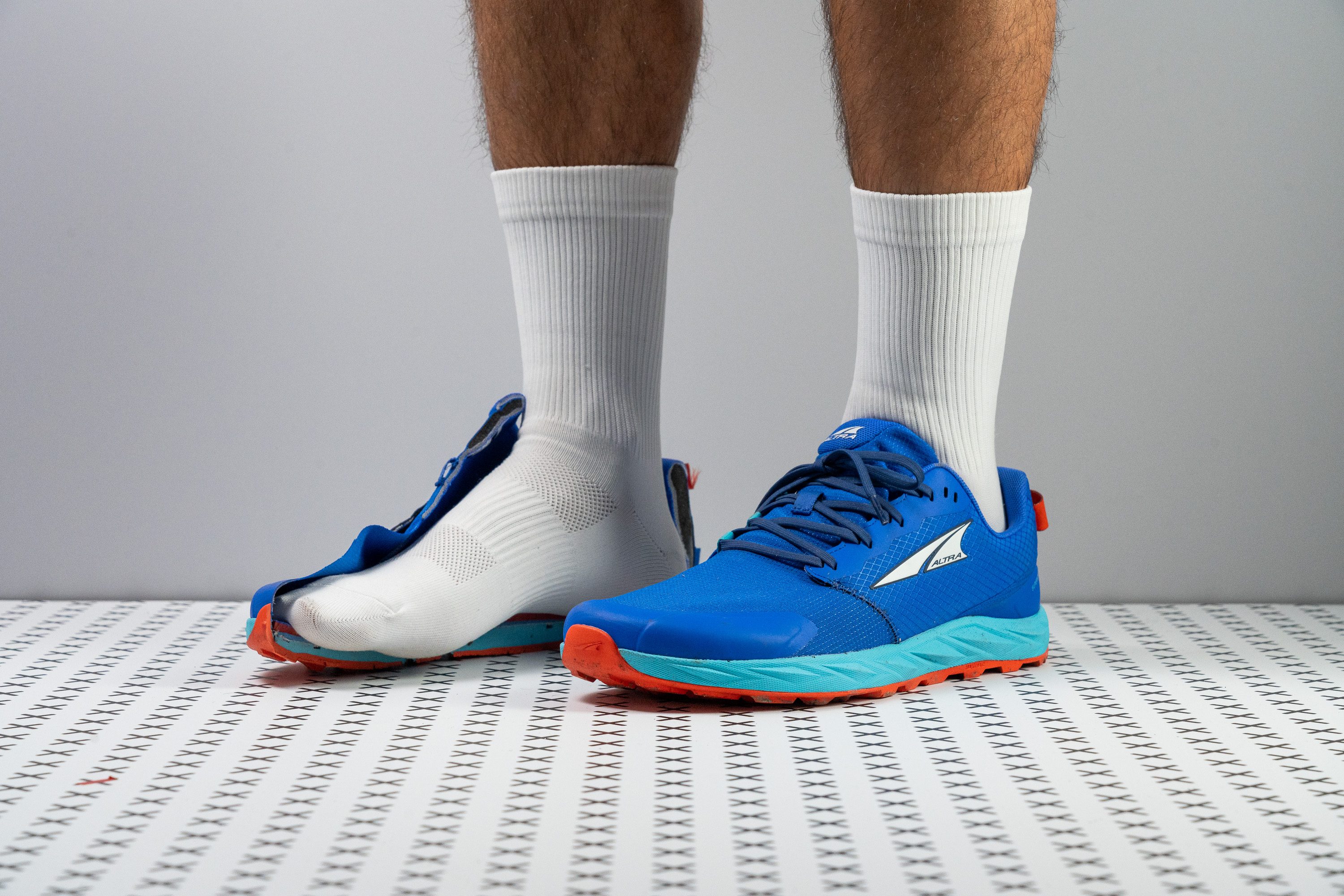














































What makes it the best?
The Superior 6 boasts its airy build, stability, and agility in our intensive runs and extensive lab tests. In true Altra nature, it offers a barefoot feel with its non-existent drop. It made us feel really nimble and connected to the trails—making it our best lightweight Altra trail runner.
Lifting our feet and picking up the pace feels effortless with its superior lightness. Our scales reveal a mere 9.6 oz (272g), 7.2% below the average. This is attributed to its grounded 22.1/22.0 mm cushion, which has 31.6% less foam in the heel than average. Its almost-zero drop delivers surface feedback that allows us to adapt to various terrains.
The ride feels stable all the way. Other than its low profile, the firm cushion helps. Our durometer reveals 29.1 HA, 11.5% firmer than average. Because of its inherent stability, it doesn’t need rigid features to keep us steady. Superior 6 increases its flexibility to boost comfort and agility on uneven terrains.
Underfoot lies a very protective and durable MaxTrac rubber. Our durometer reveals a solid 91.0 HC, 6.9% harder than average. To ensure grip, it has 3.6 mm lugs that cling to loose gravel and moderate trails.
Unfortunately, due to the shoe’s lightweight and minimal nature, it does not have enough cushioning for longer trail runs.
Pros
- Exceptional ground feel for a more connected run
- Nimble and quick
- Excellent breathability
- Upper and tongue designed for maximum comfort
- Durable outsole with reliable grip
- Remarkable stability
- Comfortable for all-day wear
- Reasonably priced
Cons
- Lacks a rock plate
- Not ideal for long distances
- The upper could be more durable
Altra trail running shoes with the best comfort
















































What makes it the best?
Through countless hours in the lab and in the mountains, we found the Experience Wild to be the best comfortable Altra trail running shoe. It’s a low-drop, high-cushioned shoe that offers endless comfort, a stable ride, and a roomy fit.
We measured a substantial amount of cushioning beneath our feet, with precise measurements of 34.5/30.2 mm. It feels comfortable for long mileage and our durometer agrees with a softness reading of 17.5 HA. It features a low 4.3 mm drop that’s perfect for transitioning to zero-drop shoes because it isn’t as harsh on our lower leg muscles.
To compensate for its height, Experience Wild widens its base to offset any imbalances. Our caliper shows a generous 114.6/94.5 mm landing base. Even the toebox gives generous real estate for our natural toe splay, barely tapering to 79.3 mm in the front area.
Unfortunately, our experience with this shoe doesn’t feel wildly energetic. Runners seeking more responsiveness should find a high-performance shoe.
Pros
- Exceptionally roomy toebox
- Good transition shoe towards zero drop
- Ultra-plush tongue for top comfort
- Well cushioned for long adventures
- Versatile for hiking and running
- Good stability for heel strikers
- All-around durability
- Compatible with external gaiters
- Reasonable price
Cons
- Midsole lacks energy return
- Low heel collar allows debris in
- Non-gusseted tongue
- Not for narrow feet
2 things you must know about Altra trail shoes
Trail runners usually opt for Altra shoes when they want that more natural running feel that is accomplished thanks to the foot-shaped design and lower or zero drop.
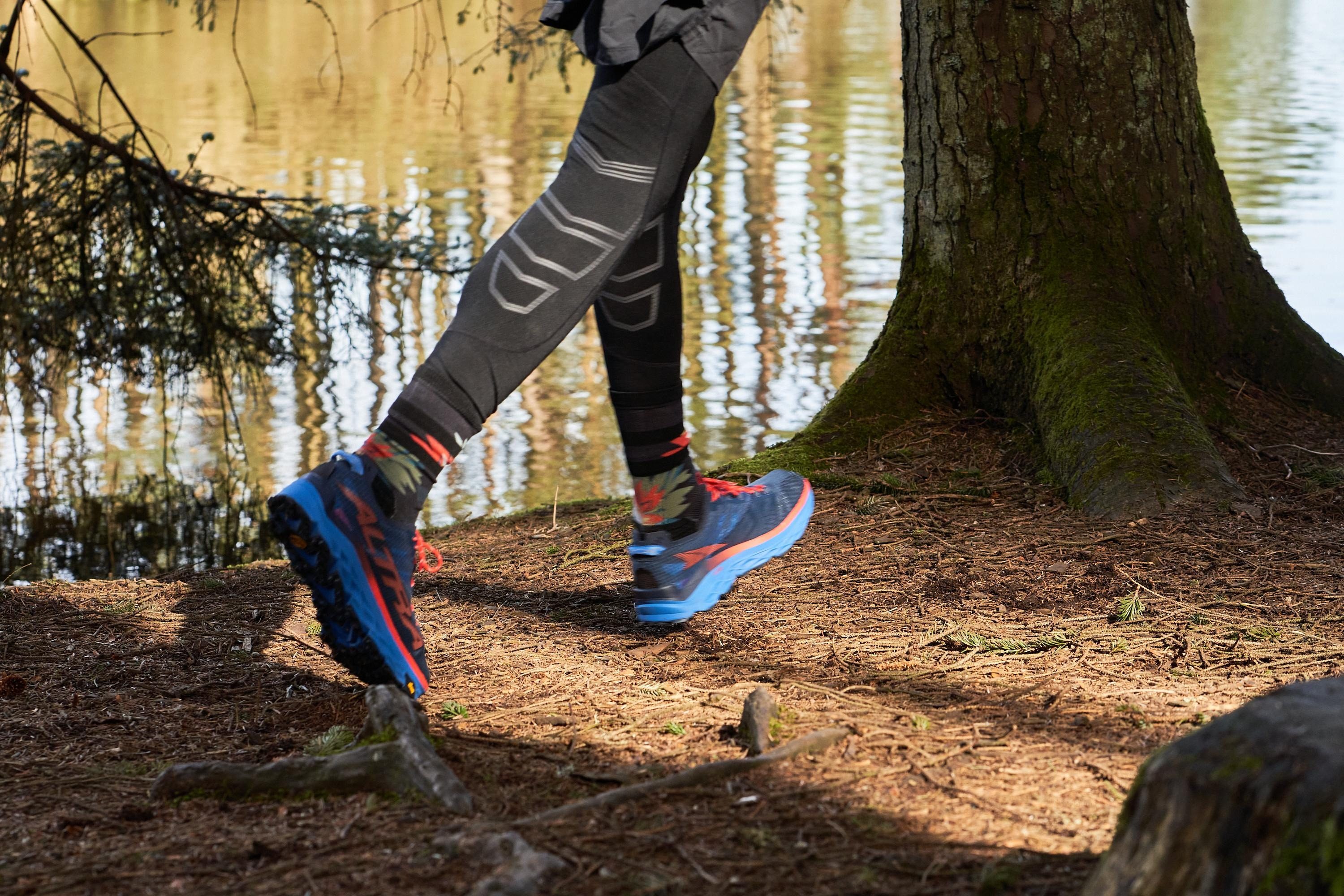
There are 2 features that make Altra trail shoes special:
- Foot-shaped design. They trademarked this design, and it comes in 3 widths: Original, Standard, Slim. This shape allows your toes to splay or at least not be cramped in. This way, the shoes promote the natural running feel.
- Altra shoes are zero-drop or low-drop. That means that their heel drop is 4mm or lower.
We will dig deep into both features below.
When NOT to get Altra trail shoes
The 2 features that make Altra shoes so special are also features that might not be for you. Because of that, we have to warn you. Don’t get Altra trail shoes if you:
- Have very narrow feet, especially at the forefoot. Even the narrowest Altra design (called Slim) isn’t narrow when looking at the big picture. We actually compared the toebox widths of Altra’s Slim shoes to the average toebox widths of all running shoes and they are close to the average but not narrower than the average.
- Are not used to the zero drop or low drop, or if your lower leg muscles (foot muscles, Achilles, calves) are weak/injured. We will explain this more below.
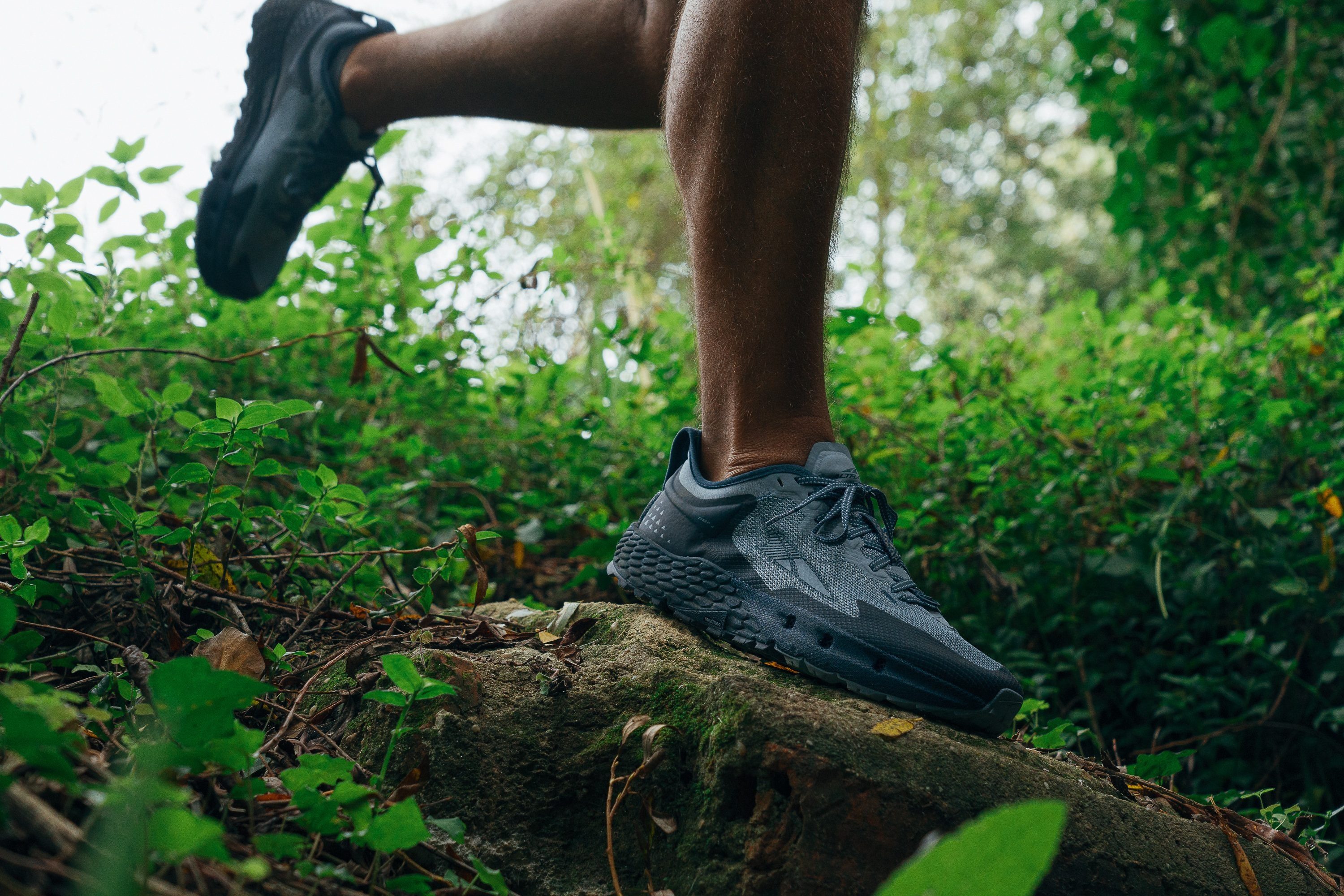
FootShape™ design of Altra trail running shoes
Most running shoes have pointy toeboxes. That pointy shape can work for some runners but surely not for all. We have many different toe shapes, which is why it’s great to have options.
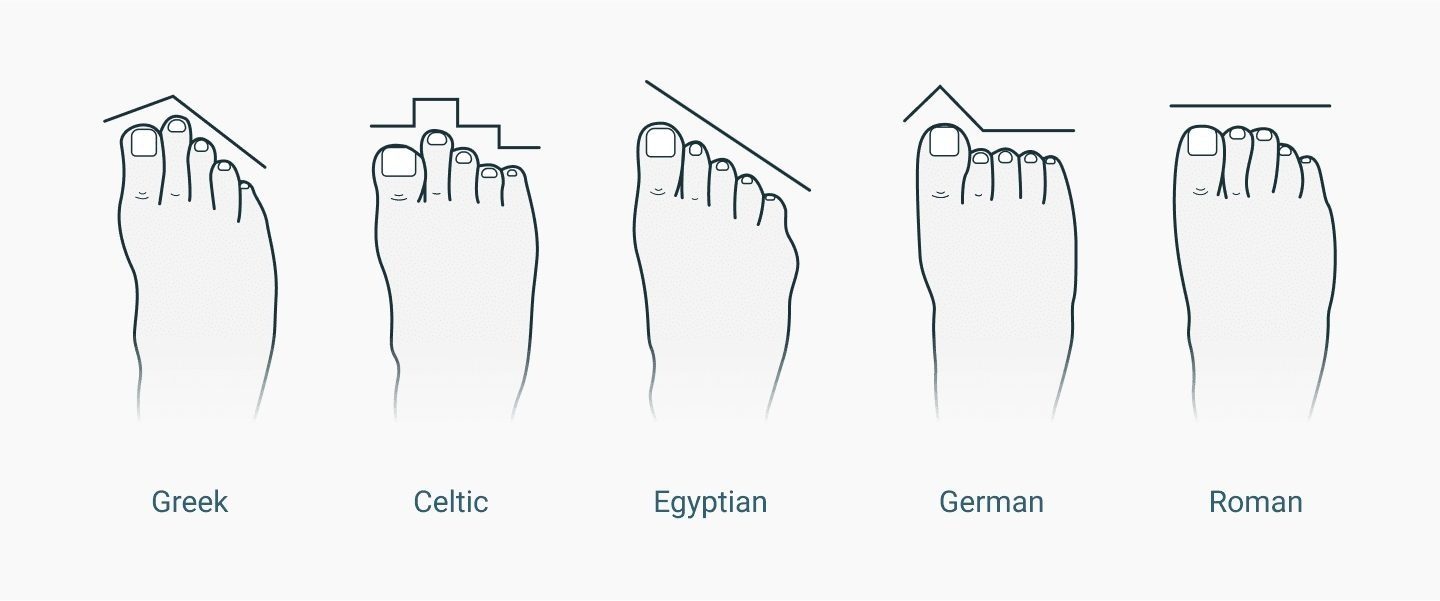
Enters Altra with their FootShape design. Enough room for toes to splay, which is especially good and healthy for those whose toes look like basically any shape but the Greek one (image above).
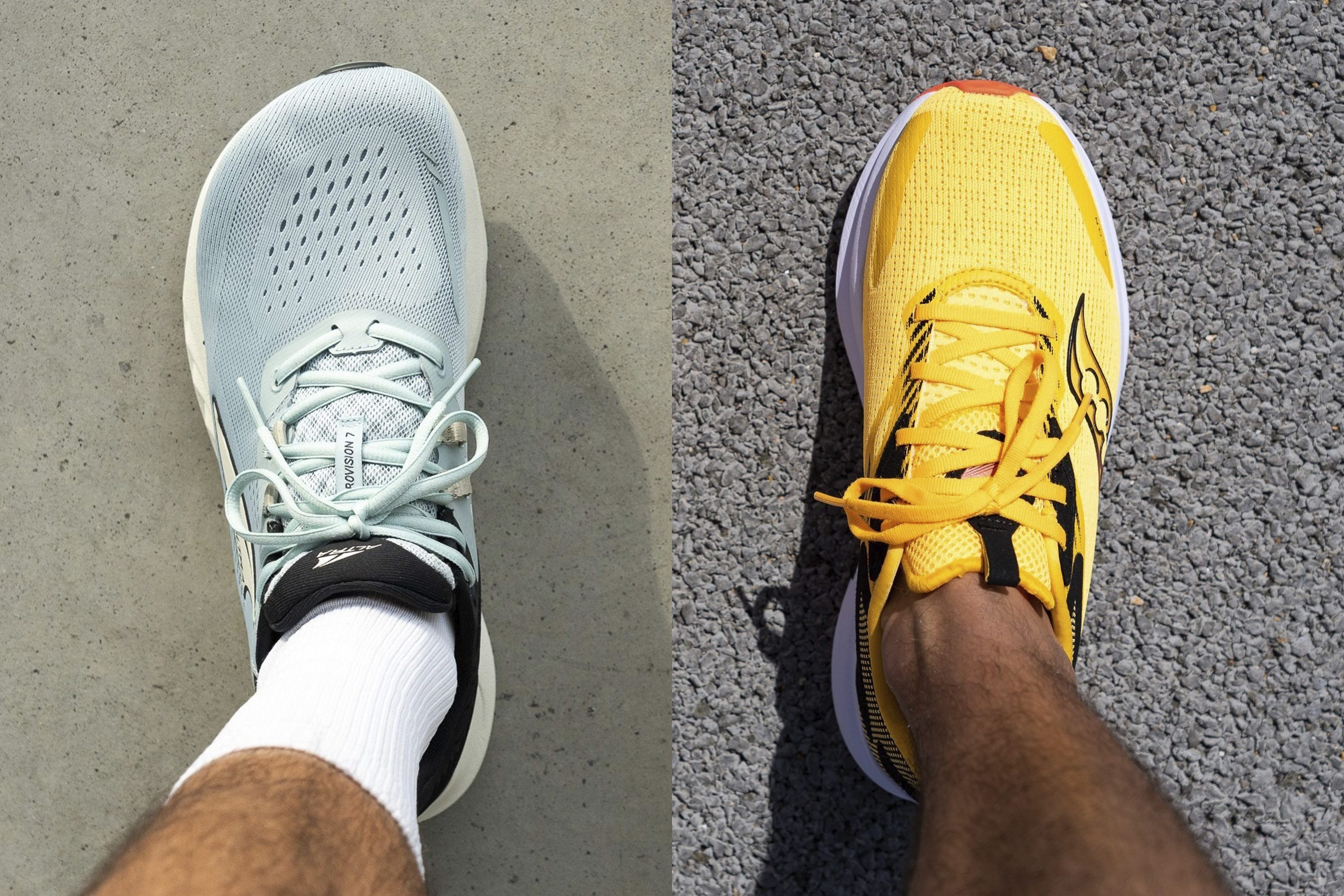
We measure the width of the shoe where it’s the widest, and the width of the toebox at the big toe. The difference between these 2 numbers tells us how much the toebox tapers. The bigger the difference, the pointier the toebox.
To get accurate toebox measurements, first, we make a gel mold of the shoe's interiors. We pour a gel into the shoe, put them in a fridge, and leave them there for 2 hours, and then measure the width of the mold
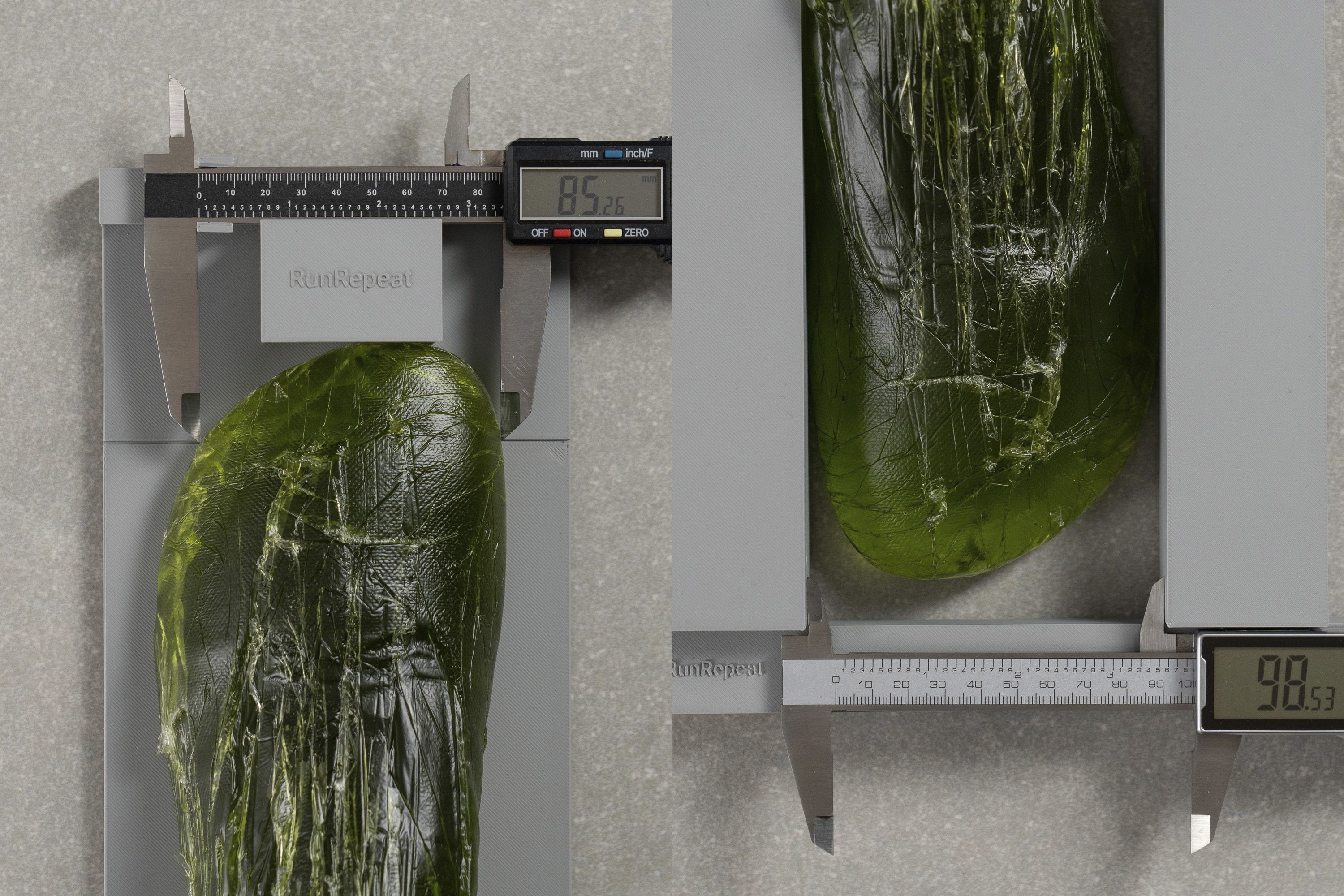
The average difference between these 2 values in Altra running shoes is 11.9 mm, while the average difference for all other shoes in our database is 20.5 mm. This clearly tells us just how pointier shoes from other brands are.
So, expect a roomy toebox.
This gel mold is also great for measuring the height of the toebox which is very important for runners who have experienced black toenails.
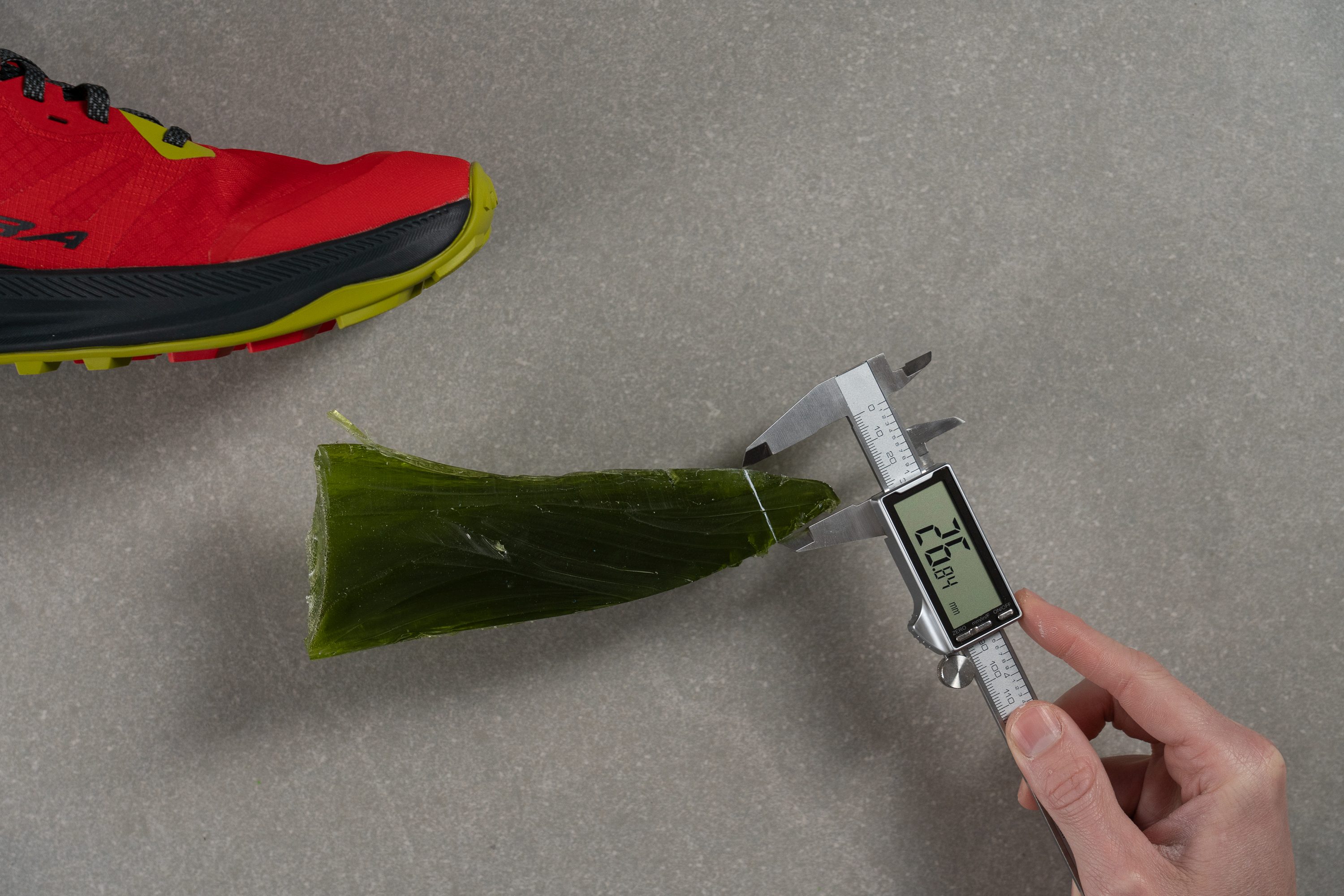
If vertical space is important to you in Altra trail running shoes, here's a selection of shoes with the highest toeboxes:
Altra widths explained
Altra makes shoes in 3 widths: Original, Standard, and Slim. Most of the shoes come in Standard width and all of them have a footshaped toebox which is not pointy.
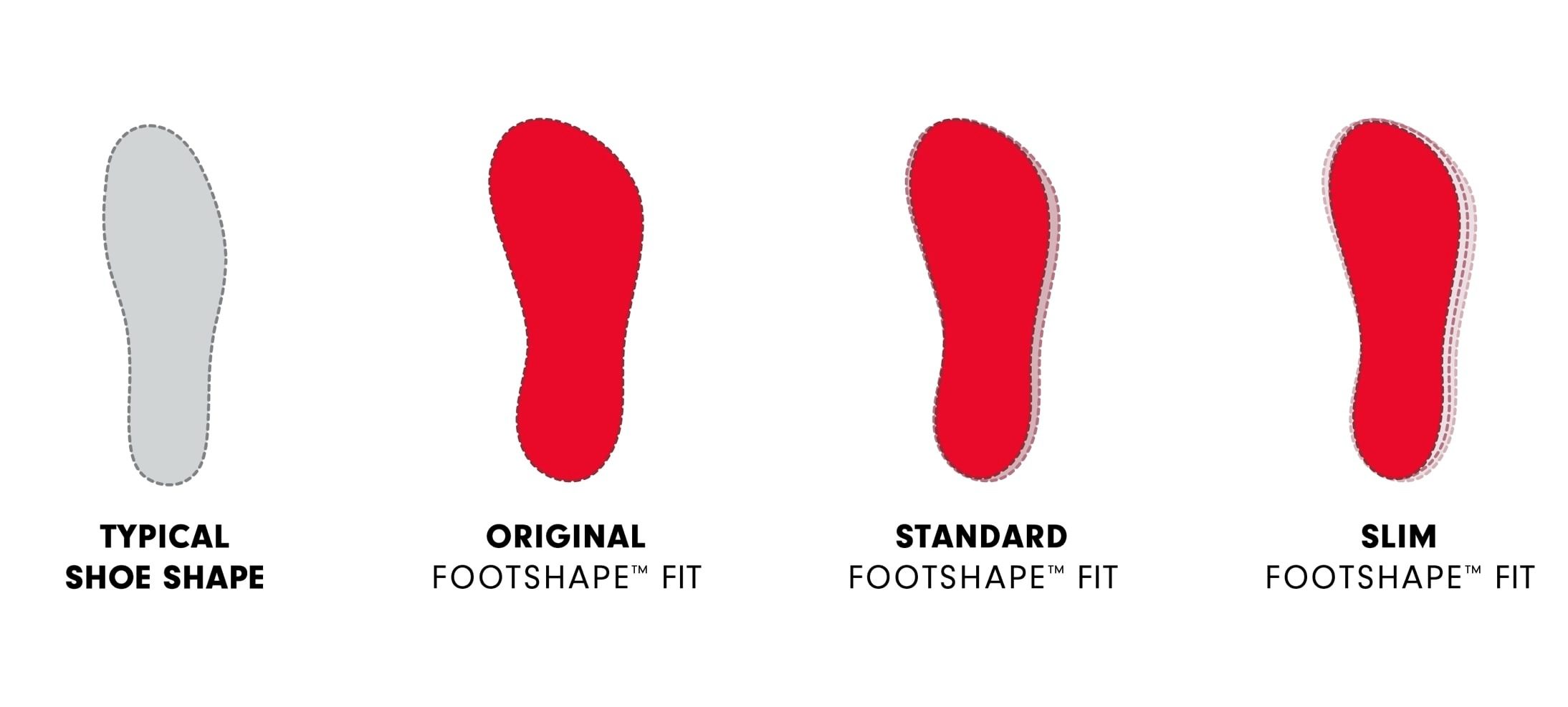
Here are Altra trail shoes in their respective fit categories:
- Original fit: Lone Peak
- Standard fit: King MT, Experience Wild, Timp, Superior, Mont Blanc
- Slim fit: Rivera, Outroad
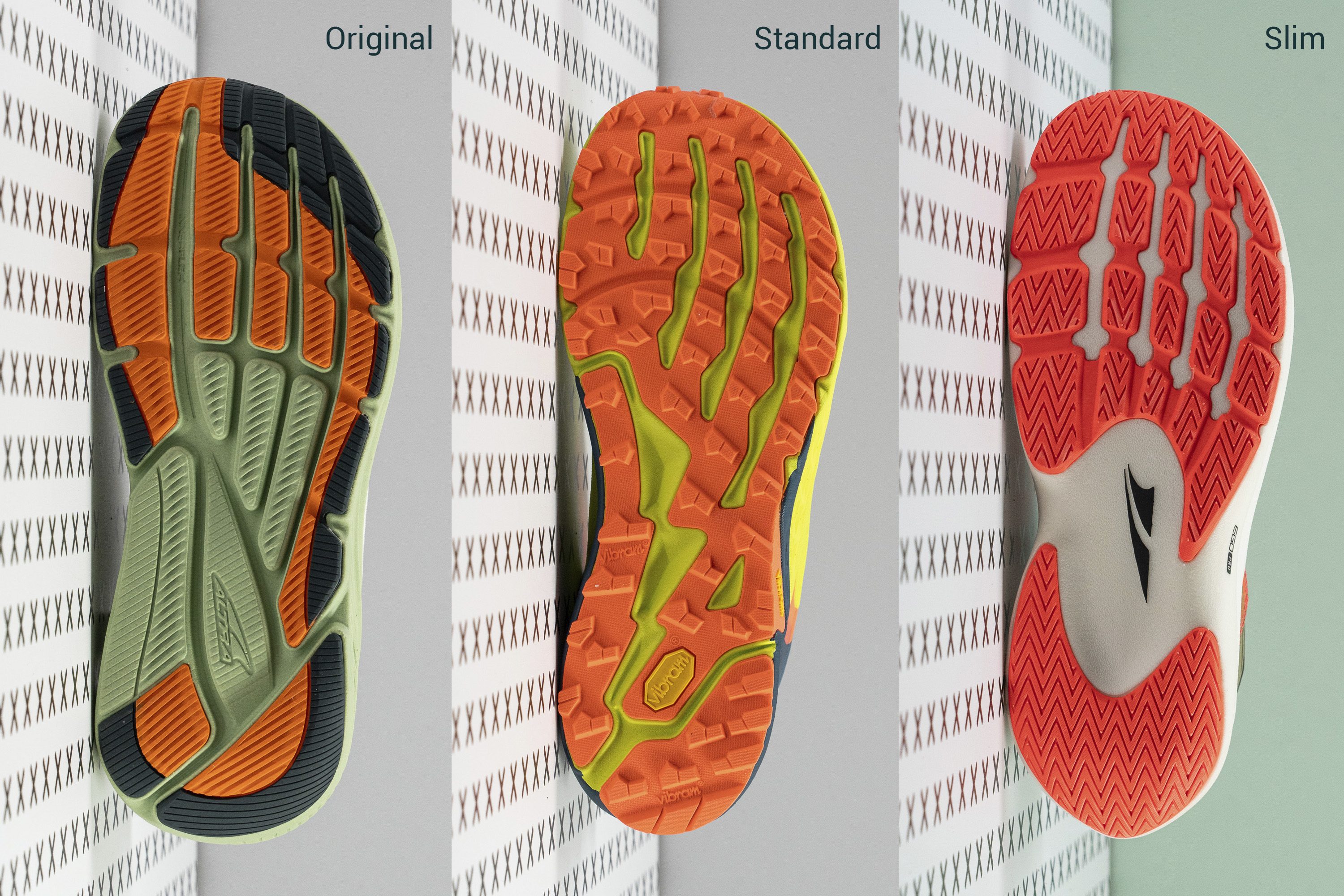
But, what does it all mean? How wide are those shapes? We looked at our lab data and realized that the Slim fit is the closest to the average in running shoes (but still, not narrower).

Our current averages for all running shoes are: 98.4 mm at the widest part and 78.3 mm at the big toe.
|
Altra’s fit |
Average shoe width |
Average toebox width |
|
Original |
102.5 |
91.5 |
|
Standard |
99.8 |
88.9 |
|
Slim |
98.1 |
84.3 |
What we see from the numbers below is that:
- the width of the shoe where it’s the widest varies, it can be narrower and wider than the average
- the toebox width is always wider than the average. This is the signature shape from Altra: their toeboxes are not just rounded but sometimes almost square-shaped
- the Slim fit is the closest to the average toebox width, which makes the Standard and the Original wider than the average
Toebox widths of ORIGINAL-shaped running shoes from Altra:
|
Shoe |
Shoe width |
Compared to the overall avg shoe width |
Toebox width |
Compared to the overall avg toebox width |
|
97.9 |
-0.5% |
92.1 |
17.8% |
|
|
103.6 |
5.3% |
90.8 |
16.1% |
|
|
104.2 |
5.9% |
92 |
17.6% |
|
|
104.4 |
6.1% |
91.1 |
16.5% |
Toebox widths of STANDARD-shaped running shoes from Altra:
|
Shoe |
Shoe width |
Compared to the overall avg shoe width |
Toebox width |
Compared to the overall avg toebox width |
|
101 |
2.6% |
87.6 |
12.0% |
|
|
101.9 |
3.6% |
92.5 |
18.3% |
|
|
97.6 |
-0.8% |
86.3 |
10.4% |
|
|
100.4 |
2.0% |
89.5 |
14.5% |
|
|
99.1 |
0.7% |
86.7 |
10.9% |
|
|
100.1 |
1.7% |
90.1 |
15.2% |
|
|
103.3 |
5.0% |
90.4 |
15.6% |
|
|
95.4 |
-3.0% |
88.3 |
12.9% |
Toebox widths of SLIM-shaped running shoes from Altra:
|
Shoe |
Shoe width |
Compared to the overall avg shoe width |
Toebox width |
Compared to the overall avg toebox width |
|
96.5 |
-1.9% |
85.7 |
9.6% |
|
|
100.5 |
2.1% |
87.7 |
12.1% |
|
|
99.4 |
1.0% |
82.8 |
5.9% |
|
|
99.1 |
0.7% |
79.5 |
1.7% |
|
|
97.1 |
-1.3% |
84.2 |
7.7% |
|
|
96.2 |
-2.2% |
86.1 |
10.1% |
Why is zero/low drop dangerous?
Dangerous might be too strong of a word, but given how many runners disregard the heel drop, we’re going with it.

Heel-to-toe drop is the difference in height between the heel and the forefoot in running shoes. It goes from 0mm to 16m. We don’t recommend runners the change to zero drop if you:
- Are not already running in low-drop running shoes
- Had or currently have weakness or injury in your foot muscles, Achilles, or calves
- Don’t have the time and patience to slowly transition to zero drop.
We try to be careful with these recommendations taking into account that the non-written industry standard for heel-to-toe drop is 10mm. It’s also what’s advised for beginners. And transitioning from 10mm to 4mm or even 0mm should take time.
Basically, any sudden change (of 4mm or higher) in heel drop is not recommended. The transition should be gradual. Runners who use shoes with 10mm drop can take even a year of transitioning to zero drop to be able to run 10-15km. The time needed to get used to the zero drop depends on many factors like your foot strike, pronation, muscle strength, past and current injuries, etc.
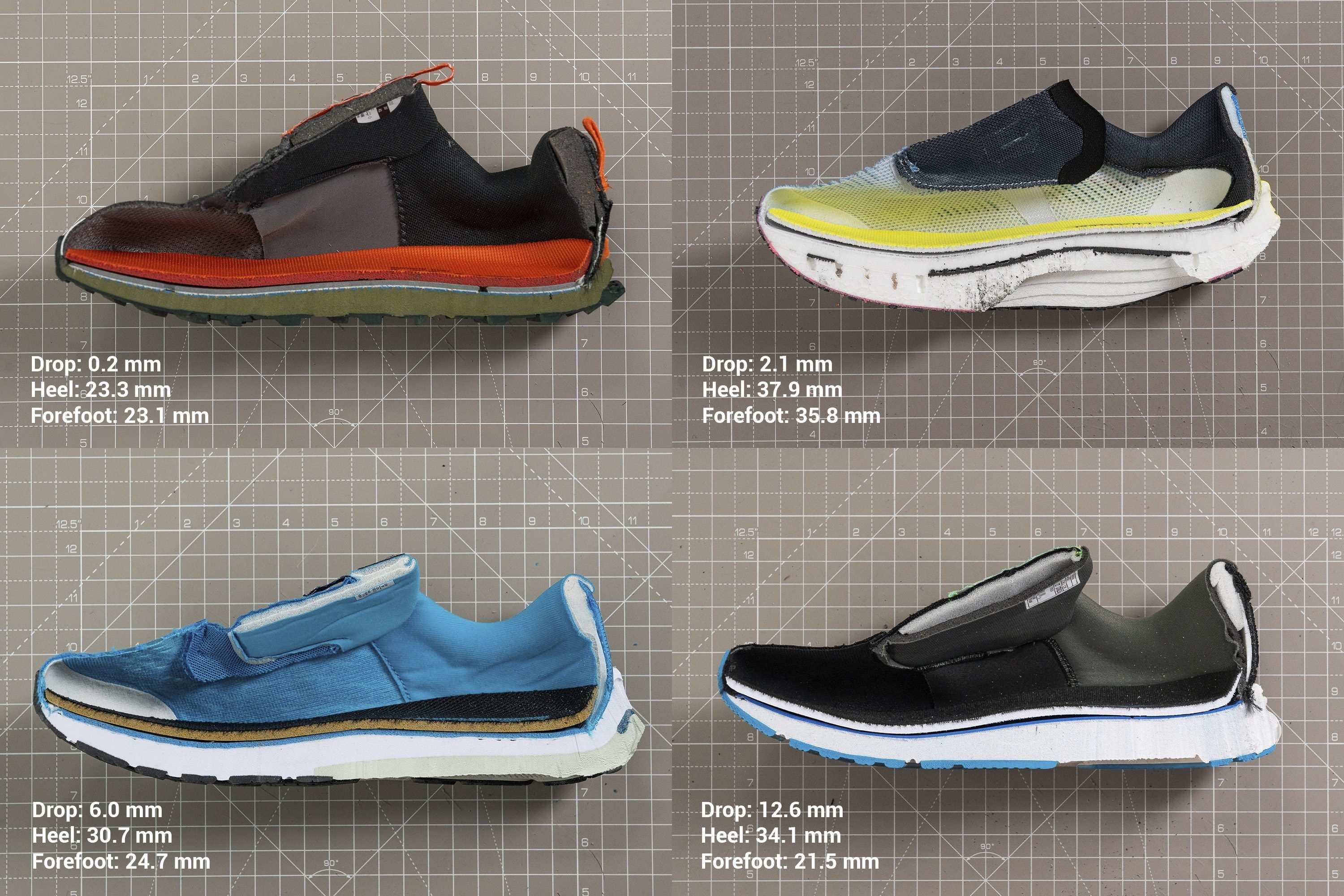
How heel drop works: the lower it is, the lower leg muscles it utilizes. Zero-drop running shoes will focus on your foot muscles the most. This is great if you want to strengthen them. Low-drop running shoes (<5mm drop) will focus on your ankles and calves. High-drop running shoes will utilize your thighs and hip muscles.
When zero drop is NOT zero drop
To be able to accurately measure the stack height, we have to cut shoes in half. This way, we stick to the guidelines written by WorldAthletics. This also allows us to accurately calculate the heel drop (heel stack height minus forefoot stack height).
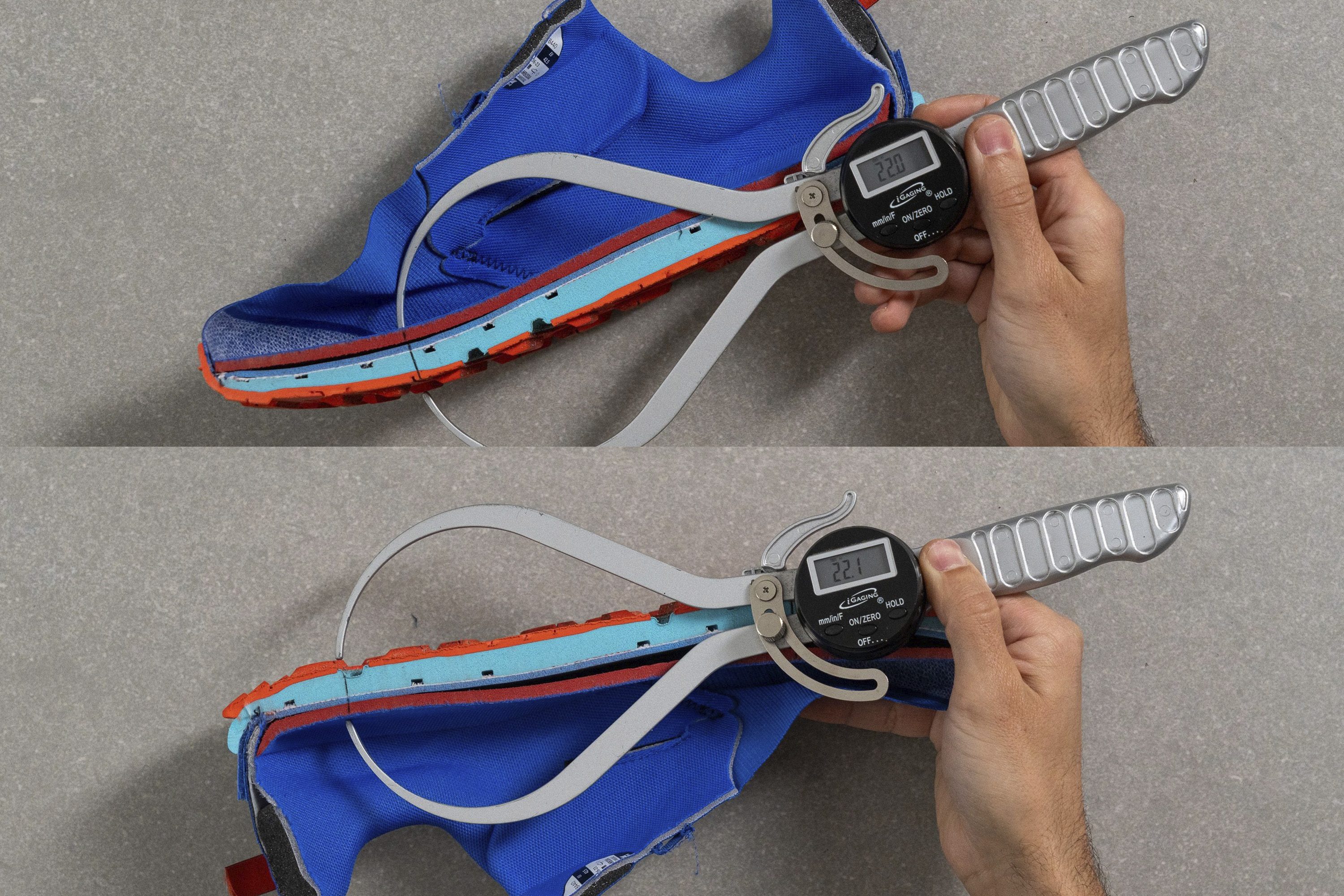
Doing so, we realized that in many cases, the advertised heel drop does not match the one we measure!
When it comes to Altra shoes, there were cases when the drop was not actually 0mm! You should be aware of this because you should not think you’re running in 0mm when, in fact, it’s a 5mm drop.
| Shoe | Lab-measured heel drop | Brand's heel drop specs |
| Altra Vanish Carbon | 5.4 mm | 0 mm |
| Altra Provision 7 | 4.8 mm | 0 mm |
| Altra Vanish Carbon 2 | 3.7 mm | 0 mm |
| Altra VIA Olympus | 1.6 mm | 0 mm |
| Altra Lone Peak 8 | 1.4 mm | 0 mm |
Best grip in Altra trail running shoes
In trail shoes, grip depends on the softness of the rubber, the durability of the outsole, the thickness of the lugs, and their pattern (orientation, number, distance).
|
Our general recommendation is to use deep lugs (4mm and deeper) for wet, soft, or loose ground like slush, snow, and mud. 2-4mm lugs are okay for wet terrain, while lugs that are 2mm thick or less work well in hybrid shoes (road-to-trail). |
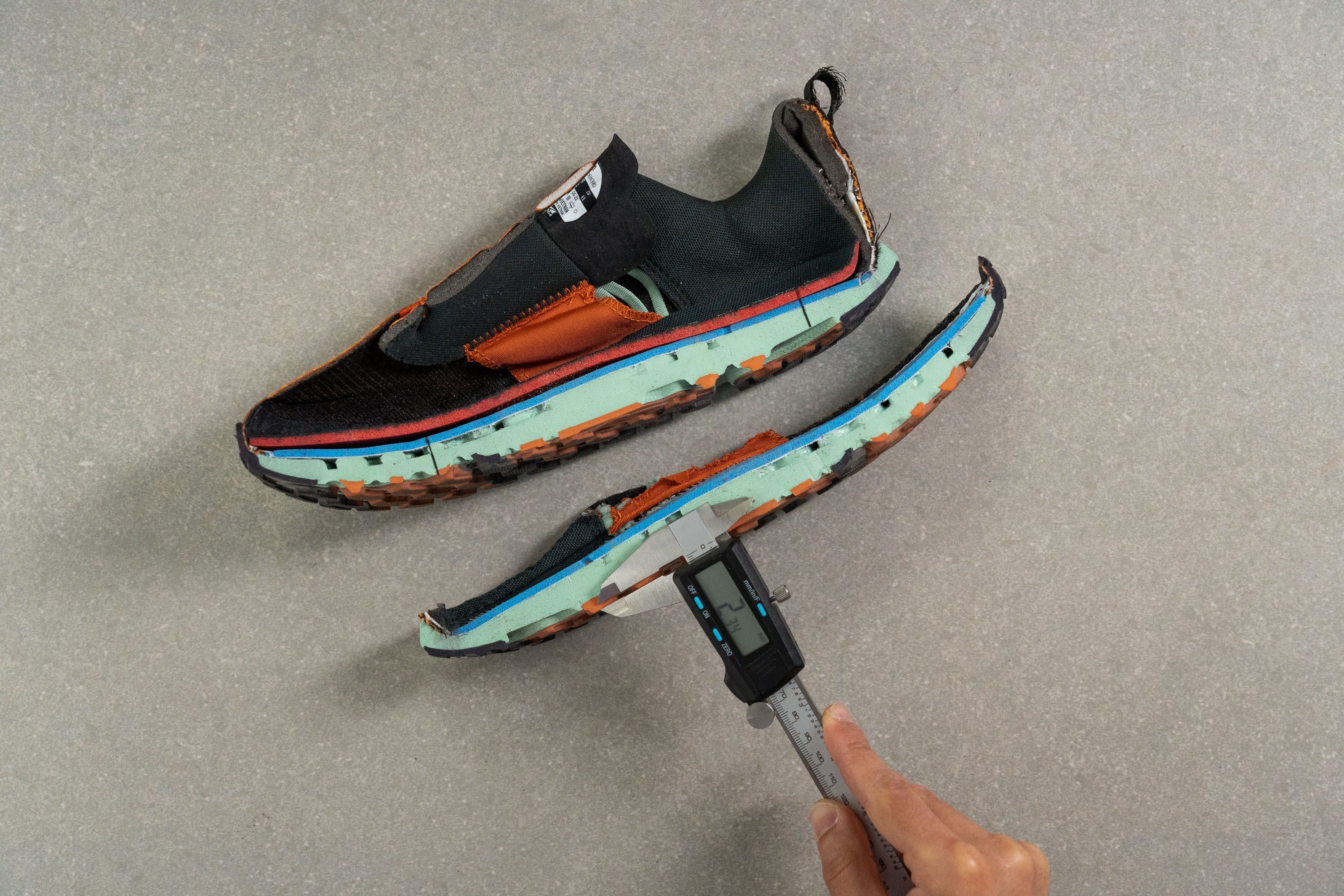
In our lab, we also measure the softness of the rubber and the durability of the outsole.
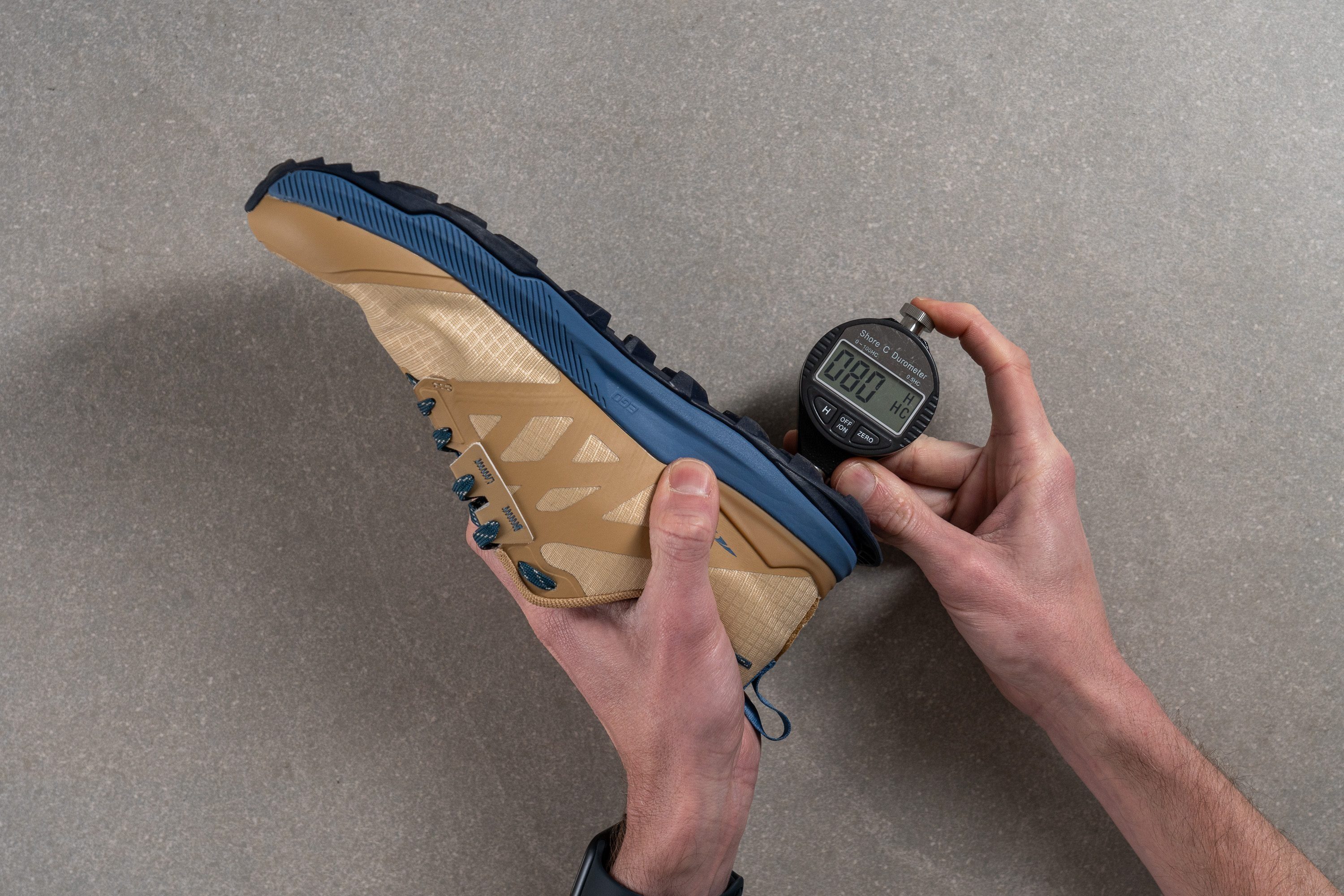
We use a shore C durometer to measure the hardness of the rubber. The higher the number on the durometer, the harder the rubber. Generally speaking, harder rubber is more protective and durable, while softer rubber is more pliable, stickier, and flexible.
Testing the durability of the outsole on Altra trail running shoes
Finally, we also test the durability of the outsole where, in trail shoes, we actually damage the lugs. We perform a standardized Dremel test where we press it against the rubber always at the same pressure, RPMs and duration.
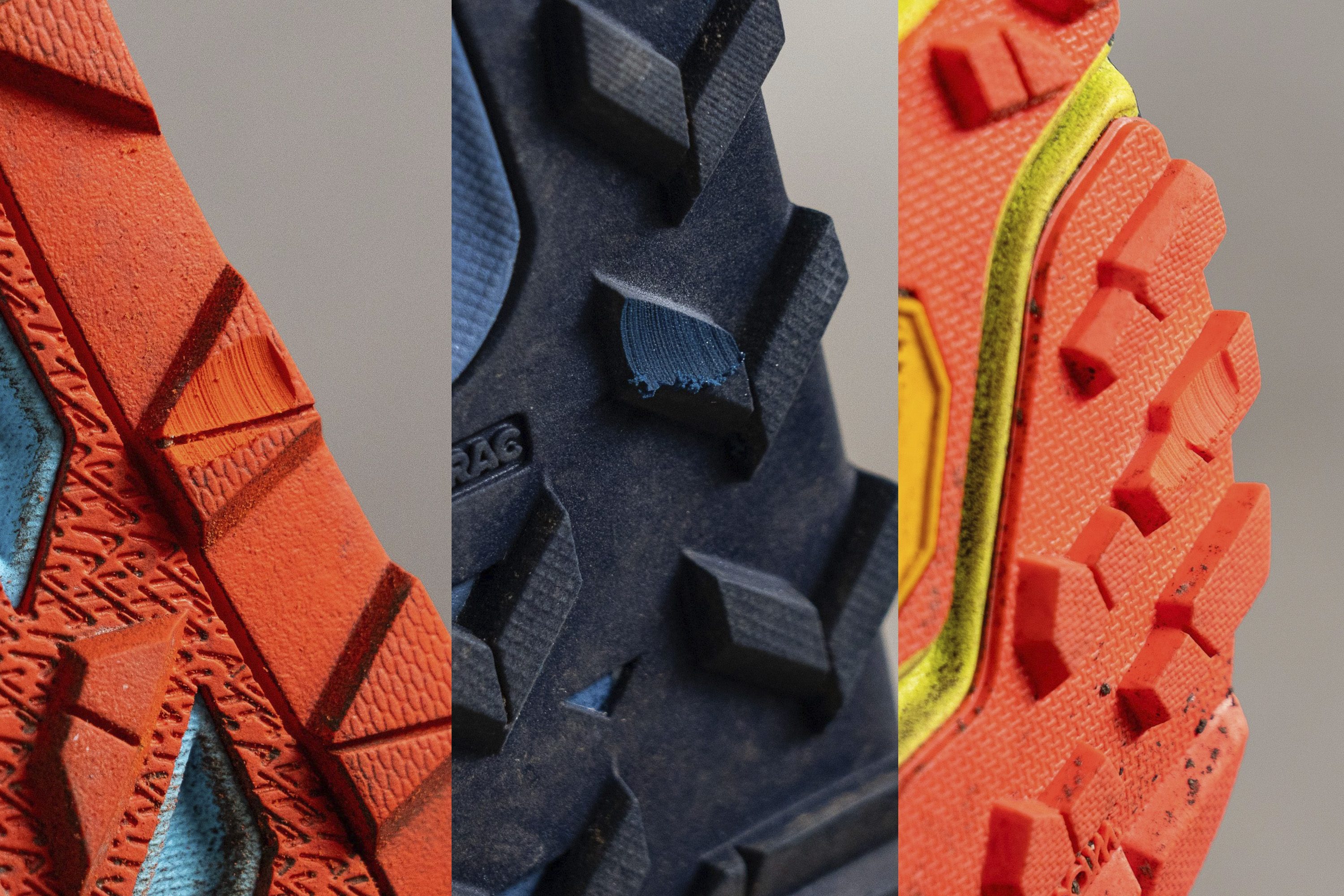
Then, we use a tire tread gauge to precisely measure the depth of the dent made on the lugs. Shallower dents mean the lugs are more durable, while deeper dents mean they will wear out sooner.
Gaiters are a huge plus!
Not many trail shoes include attachments for gaiters but Altra does. It's a velcro patch at the back and a small metal hook in front of the eyelets on the toebox. You can get Altra gaiters in different sizes so that your trail adventures stay debris-free on the inside of your shoes.




